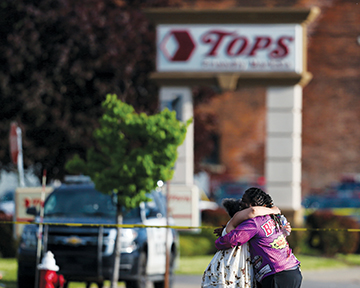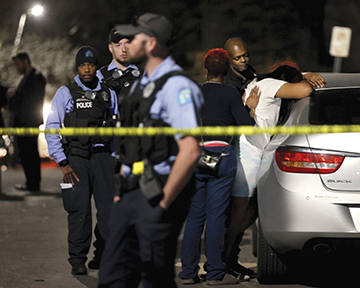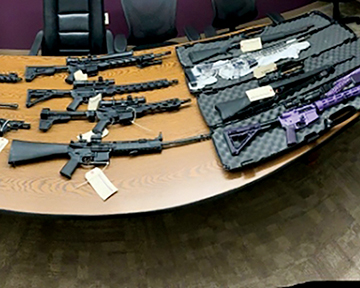By LISA EISENHAUER
Two massacres in 10 days in May — one at a supermarket in Buffalo, New York, in which 10 people were killed and another at an elementary school in Uvalde, Texas, that left at least 19 children and two teachers dead — have stunned a nation where mass shootings
and other gun violence are becoming increasingly common.
The rampages happened just days after statistics from the Centers for Disease Control and Prevention showed a spike of 14% in
gun deaths and 34% in gun homicides in 2020 from 2019. Advocates for violence prevention programs within the Catholic health care ministry say the numbers bright line a devastating trend.
"There is no room for negotiation around this, we have got to have stricter gun laws in this country," said Sr. Mary Haddad, RSM, CHA's president and chief executive officer. Gun violence, she said, is a public health crisis.
In mid-June, Congress was taking steps to address gun violence. The House approved a blanket ban on sales of large-capacity magazines and a ban on the sale of semiautomatic weapons to people under age 21. The legislation's prospects in the Senate appeared dim. Days later, Senate negotiators announced the framework of a bipartisan response that would include enhanced background checks for gun buyers under the age of 21 and funds for states to pass "red flag" laws and bolster school safety and mental health programs. The Senate proposal does not include age limits on semiautomatic weapons purchases or a ban on large-capacity magazines.

Slubowski
Plea for more funding
Mike Slubowski, president and chief executive of Trinity Health, cites the CDC's gun death figures and especially the drastic rise in gun homicides in explaining why his system sees firearm violence as a major public health issue and why it advocates
for more funding for research on what's behind the violence. "I think having better data collection and more research will help us understand the root causes and risk factors of gun violence," he says. "It would be our hope that we would find some
evidence-based solutions to the issue."

People hug outside the scene after a shooting at the Tops supermarket in Buffalo, N.Y., on May 14. The massacre left 10 people dead and three wounded.
Credit: Joshua Bessex/Associated Press
Trinity Health and CHA are among almost 300 health care organizations that signed a letter dated April 28 urging the leaders of the House and Senate appropriations committees to increase to $60 million from the
current $25 million the amount earmarked for the CDC and the National Institutes of Health to study prevention of firearm morbidity and mortality.
"In the midst of the COVID-19 pandemic, communities across the U.S. continue to suffer from the public health crisis of firearm-related injuries and deaths," says the letter.

Family members of a 12-year-old boy grieve at the scene where police say the child was shot and killed while playing with a gun that he and a 10-year-old found inside a home in St. Louis.
Credit: David Carson/St. Louis Post-Dispatch via Associated Press
CDC's latest figures on gun deaths, released in mid-May, break down the total of 45,222 gun fatalities in 2020 to 24,245 suicides, 19,350 assaults and 1,627 accidents or other causes. The agency says the total is the highest on record.
While official gun fatality figures for 2021 won't be released for months, the not-for-profit Gun Violence Archive says the data it has gathered from law enforcement agencies and other sources across the country show at least 45,000 gun deaths last year.
The group has counted more than 17,000 gun deaths through May 25 of this year and 213 mass shooting incidents.
Those shootings include the one May 14 in Buffalo that is being investigated by the FBI as a hate crime. Authorities say the 18-year-old white suspect drove 200 miles to the grocery in a Black neighborhood with the intent to kill Black people. Eight of
the 10 people who died were Black.
The school shooting May 24 in Texas, with 21 dead according to early reports, was second in lethality among elementary and high school shootings only to the one in Newtown, Connecticut, in 2012 that claimed 26 lives, including 20 children. Authorities
say the 18-year-old gunman in Texas opened fire in a fourth grade classroom.
A day before the Texas shooting the FBI released a report showing that active shooter incidents — those in which at least one gunman kills or attempts to kill people in a populated area — increased more than 50% in 2021 from the year before. Those incidents left 103 victims dead and 140 wounded.
No safe havens
Slubowski points out that Trinity Health's advocacy efforts around gun violence include supporting the Break the Cycle of Violence Act sponsored by Sen. Cory Booker, D-New Jersey, and other lawmakers. That measure calls for investing at least $5 billion in federal funding over eight years for community-based
gun violence prevention programs.
Violence isn't just an issue outside the doors of medical facilities. Federal statistics show an upward trend in workplace violence toward care providers.
Slubowski says Trinity Health, like other health systems, has had violent incidents on its campuses targeted at both providers and patients, some of them involving guns. "We're spending significant resources to enhance security measures," he says.
The cost of gun violence includes the physical and emotional toll violence and the threat of violence take on a health care workforce that health care executives say is strained and traumatized by the COVID pandemic.
Call to action
In a statement released hours after the school shooting in Texas, Sr. Mary said: "On behalf of Catholic health providers across the United States, we are horrified, but sadly not shocked, about the news of another massacre
and loss of so many lives. CHA has long advocated for sensible firearms policies, including banning weapons that enable the slaughter of many people in a matter of seconds. We also believe it is important to support research into the root causes of
gun violence."
The CDC says gun injuries surpassed motor vehicle crashes as the leading cause of death for children and adolescents in 2020. Researchers say 4,357 children and teens were killed by guns in that year.
The new CDC figures also show that firearms continue to take a particularly harsh toll on communities of color, with 77% of gun homicide victims identified as Black or Hispanic.

Pontemayor
Paulo Pontemayor, a CHA director of federal government relations, points out that zeroing in on health issues that disproportionately affect minority populations is part of the We Are Called campaign that CHA launched last year to confront racism by achieving health equity. Most CHA members have joined the initiative.
Pontemayor agrees research is the key to identifying causes for the violence and its disparate impact and to crafting successful interventions. "We truly are called to find ways that we can mitigate this and to find ways that we can all be safe and healthy
and thriving in our communities," he says.
Playing catch-up
A congressional decree in 1996 that "none of the funds made available for injury prevention and control at the Centers for Disease Control and Prevention may be used to advocate or promote gun control" effectively
halted federal research into gun safety. The decree came amid heavy pressure from the National Rifle Association to eliminate the CDC's National Center for Injury Prevention and Control after a study it funded in 1993 showed gun owners were at higher risk for violent crime in their home.
The center survived but federal appropriations for gun violence research dried up until 2018 when lawmakers appropriated $12.5 million each to the CDC and the National Institutes of Health. They did so again in the next two federal budgets. The studies
the appropriations are funding remain in progress.
The letter CHA and the other health-related organizations sent to congressional appropriations leaders urging more funding notes: "A recent, rigorous report estimated that the federal government will need to spend approximately $100 million per year to
fully fund a comprehensive research agenda on reducing gun violence."
Analyzing, advocating
Laura Krausa, who oversees CommonSpirit Health's violence prevention programs as the system director for advocacy programs, says health care providers know the importance of having reliable data to inform their
work. "Gun violence data at that macro level will be the data that informs public policy strategies and prevention and intervention strategies," she says.

Krausa
She adds that CommonSpirit providers across its 21-state footprint cared for 3,149 patients who had gun injuries in the fiscal year that ended June 30, 2021. The cost of their medical treatment was $32 million.
A third of those patients were assault victims; the rest were injured in gun accidents. However, the assault victims tended to incur the most egregious injuries and require the highest acuity care, Krausa says. "Two-thirds of the costs were for assault
and a third for accidental shootings, which I think speaks to the particularly devastating nature of assault and potentially the kinds of weapons that are used," she notes.
Krausa says CommonSpirit uses its patient data on gun violence to inform its education and prevention strategies, including systemwide approaches to reducing gun violence as well as specific interventions with partners at the community level. She points
out that within the CommonSpirit system, assault-related injuries are more common in urban areas and hunting accident injuries more likely in rural areas.
"We need to make sure we're always measuring, because we want to make sure that whatever we're doing is actually working," she points out.
In addition to advocacy efforts around gun safety policies and partnerships in community-based violence intervention programs, CommonSpirit's violence prevention efforts include shareholder advocacy. The system urges companies to adopt policies that enhance
gun safety. For example, Krausa says, CommonSpirit has engaged in efforts to pressure credit card companies to stop allowing sellers of "ghost guns" to use their services in transacting sales of untraceable firearms and components.
Gun safety focus
Both Krausa and Slubowski say that in advocating for violence prevention efforts their systems are respectful of the sensitive nature of discussions around gun ownership in the U.S.
Krausa says CommonSpirit has issued statements making clear its position that "the Second Amendment can absolutely peacefully exist with sensible and reasonable solutions to gun violence."
Slubowski says Trinity Health's support for research and prevention efforts around gun violence is not a political stance but rather an extension of its mission to be a compassionate and transforming healing presence in the communities it serves. "Safety
is one of our core values," he says, "and ultimately our goal is to improve the health of communities and to keep people safe."
Urging action to address gun violence
CHA has a long record of advocacy efforts in partnership with other health care and faith-based organizations aimed at reducing gun violence. The efforts include calling on Congress to:
- Ban the purchase and sale of assault weapons.
- Ban the purchase and sale of high-capacity ammunition magazines.
- Establish universal background checks and close the private gun sale loophole.
- Close the Charleston loophole, which permits federally licensed dealers to sell guns to a buyer if three business days pass without the FBI having completed a background check.
- Repeal the Dickey Amendment and restore funding to the Centers for Disease Control and Prevention for research on gun violence.
- Oppose expanded concealed carry reciprocity legislation, which seeks to turn houses of worship into congregations armed with guns and weaponry.
- Enact a gun violence restraining order law, which would temporarily prohibit an individual from purchasing or possessing firearms when deemed by a judge to pose a danger to self or others.
- Oppose legislative efforts to deregulate the purchase and sale of gun silencers.
- Close the boyfriend loophole, which allows convicted abusers and stalkers to buy and own firearms.
U.S. gunmakers ramp up production threefold in 20 years
The number of guns made by licensed manufacturers in the United States increased in 2020 to 11.3 million, almost three times as many as were made in 2000, according to a report released May 17 by the Department of Justice.

Privately made firearms, also known as "ghost guns," seized by police in Pennsylvania.
Credit: David Carson/St. Louis Post-Dispatch via Associated Press
Over the same period the number of guns imported into the country jumped 350% and the number exported spiked 240%, the report shows.
The report was produced by the Justice Department's Bureau of Alcohol, Tobacco, Firearms and Explosives. It was requested in April 2021 by President Joe Biden and Attorney General Merrick Garland as part of the department's strategy to combat
the rise in violent crime, according to a media statement that accompanied the release of the 306-page report on May 17.
"We can only address the current rise in violence if we have the best available information and use the most effective tools and research to fuel our efforts" said Deputy Attorney General Lisa O. Monaco. "This report is an important step in that
direction. The department will continue to gather the data necessary to tailor our approach at the most significant drivers of gun violence and take shooters off the streets."
Among the report's other findings:
- The number of firearms manufactured per 100,000 people in the U.S. in 2000 was 1,397; in 2020 it was 3,410.
- The number of suspected privately made firearms, also known as "ghost guns," recovered by police increased tenfold between 2016 and 2021, when 19,344 of the untraceable guns were confiscated.
- Pistols dominate the market, with 5.5 million made in the U.S. in 2020 compared to 2.8 million rifles.
- The number of short-barreled rifles manufactured annually increased 24,080% between 2000 and 2020.
- Between 2000 and 2020, annual silencer manufacturing volume increased 3,699%.
— LISA EISENHAUER
Ministries' partnerships put violence prevention efforts into practice
CommonSpirit Health is among the Catholic health systems making community partnerships key to its efforts to reduce violence, including assault, bullying, child abuse, youth violence, intimate partner abuse, human trafficking and gun violence.
Laura Krausa has overseen violence prevention programs for more than a decade for Catholic Health Initiatives, which joined with Dignity Health in 2019 to form CommonSpirit Health. As system director of advocacy programs at CommonSpirit, she continues
to provide guidance for the community-based violence prevention initiatives which the organization has funded over the years with $35 million in grants.
One of CommonSpirit's long-standing partnerships is with the Chester Community Coalition in Delaware County, Pennsylvania. Chester has a population of about 34,000 and a homicide rate 25 times higher than elsewhere in the county.
CommonSpirit provides funding for a program that uses the evidence-based Sanctuary Model to create a trauma-informed community and safe and healing environments for children, families and adults who have experienced chronic stress and adversity.
The program taps the services from a coalition of groups to provide a range of bereavement and trauma-informed interventions for those aged 8-18 who have been impacted by homicide.
"The coalition and its work is facilitated by the money that we've put into it and we're essential in helping to connect all the dots," Krausa explains.
One of Trinity Health's community-based violence prevention efforts is Hartford Communities That Care, a partnership through its Saint Francis Hospital and Medical Center in Hartford, Connecticut. The collaborative uses distinct and overlapped
programs and service models to address violence and trauma in underserved parts of the city.
Part of the effort is a hospital-based violence intervention at Saint Francis that connects shooting victims and their families to various services, including medical, mental health and social support. Mike Slubowski, president and chief executive
of Trinity Health, says over the program's several years in existence more than 1,800 gunshot victims have availed themselves of it. In May, the city announced that the program would be expanded across Hartford through a partnership involving
several organizations, including Trinity Health, two other health systems and Hartford Communities That Care.
SSM Health Cardinal Glennon Children's Hospital and SSM Health Saint Louis University Hospital are among four hospitals in St. Louis taking part in an initiative called Life Outside of Violence.
The program uses grant funding to cover the salaries of social workers who provide case management, therapy, counseling and mentoring services for any victim of gunshot, stabbing or assault age 8-24 who comes into emergency rooms for care.
— LISA EISENHAUER